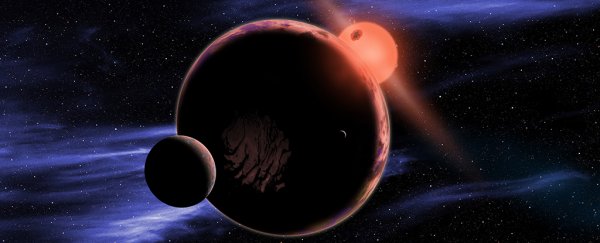NASA has come up with a new model for figuring out whether a distant planet could be considered habitable. And when we apply it to the recently discovered rocky world orbiting our nearest stellar neighbour, Proxima Centauri b, we might have to rule it out as a suitable home for alien life.
Proxima Centauri b was first announced back in August last year, to much fanfare. Not only was this planet roughly Earth sized and in the 'Goldilocks zone' of our closest neighbouring star system, but there were hints that it could be covered in water.
People were so excited by about the planet's proximity and potential to host life that within days, Russian billionaire Yuri Milner had come up with a plan to travel the 4.37 light-years and visit the planet with our own technology within the next 50 years.
But new research from NASA suggests that Proxima Centauri b is likely to be a dead world, thanks to the violence of its host star.
You've probably heard of the Goldilocks zone before - an area around a star which is 'not too hot, not too cold' for liquid water to puddle on a planet's or moon's surface.
Also described as a star's circumstellar habitable zone, this band of space is generally seen as a good place to start a search for signs of life in other solar systems. It's based on the guiding principle of wherever we've found liquid water on Earth, we've also found life.
Of course, just being a planet inside a habitable zone is no guarantee that it will also have life-sustaining oceans. Lacking a decent atmosphere would make it hard for water to remain a liquid. Having an atmosphere that traps too much heat would also be bad news for condensation.
Yet it's seen as a good place to start a hunt for life-supporting planets and moons. Until recently, the main qualities that have determined the mapping of the Goldilocks zone have been the radiative flux - or sunshine - from the star, and the mass of the orbiting body.
With the discovery of massive super-Earth planets, astronomers have created two kinds of habitable zone - a thin one for puny rocky worlds like ours, and a wider one for planets that could hold thicker atmospheres and produce more powerful protective magnetic fields.
Now, researchers from NASA's Goddard Space Flight Centre advise taking into account the space weather whipped up by the parent star's solar activity.
With enough stellar eruptions sending streams of charged particles and radiation into space, planets that we might consider to be in a habitable zone could have their atmosphere stripped of the ingredients needed to make water.
"If we want to find an exoplanet that can develop and sustain life, we must figure out which stars make the best parents," said one of the team, NASA solar scientist Vladimir Airapetian.
One kind of star which makes for a rather abusive parent is the red dwarf. These are small stars less than half the mass of our own Sun, with slightly cooler surface temperatures below 4,000 degrees Celsius (about 7,200 Fahrenheit).
Given their weaker glow, it's easier to spot planets orbiting these stars. Yet their Goldilocks zone was thought to be close and tight, which would increase the chances of any small rocky bodies within that zone behaving like our Moon - tidal locked with one surface slowly roasting in starlight.
Several years ago, an atmospheric physicist from the University of East Anglia in England suggested changes to the model based on how ice might absorb light from a red dwarf.
This pushed the habitable zone out a little further, raising hopes that the relatively abundant red dwarf star systems in our galaxy could be worth paying attention to for alien planet hunters.
NASA's models have poured cold water over this idea.
"On the downside, red dwarfs are also prone to more frequent and powerful stellar eruptions than the Sun," said team member William Danchi. "To assess the habitability of planets around these stars, we need to understand how these various effects balance out."
Stellar eruptions generate bursts of high energy radiation which break molecules into their constituent atoms and ionise them. Electrons that are knocked off in the process are easily lost to space, leaving behind a bunch of similarly charged particles.
Over time, the positively charged particles are lured away from the planet's surface in a process called ion escape, eroding the atmosphere. As the lightest element, hydrogen is most vulnerable to this process.
To figure out how this would effect the presence of water, NASA modelled the powerful superflares produced by red dwarfs and noted their effect on the hypothetical atmospheres of nearby orbiting planets.
They found heavier elements such as oxygen and nitrogen were also stripped away from the planet's gravity, potentially making the world uninhabitable within a hundred million years.
Given these heavier elements are likely to play a role in forming life as we know it, not to mention the loss of the building blocks of good old H2O, it's unlikely that any planets close enough to a red dwarf to allow water to collect as a liquid would have any water at all.
When we apply this model to the recently discovered Earth-sized exoplanet orbiting our nearest neighbour - the red dwarf Proxima Centauri - we find it's likely that it lost most of its atmospheric oxygen within its first 10 million years.
This is in contrast to earlier speculation that it could host a vast ocean. Add to that frequent solar storms and intense magnetic activity, and Proxima Centauri b is arguably far from an ideal place for life to flourish.
As Airapetian puts it, "As we learn more about what we need from a host star, it seems more and more that our Sun is just one of those perfect parent stars, to have supported life on Earth."
This research was published in Astrophysical Journal Letters.
